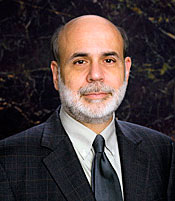Noteworthy
Bernanke’s Virtual QE3
 When the Federal Reserve’s FOMC met in December it issued a statement that suggested economic conditions “are likely to warrant exceptionally low levels for the federal funds rate at least through mid-2013” many observers started expecting a new round of Quantitative easing aka QE3. Then in January, the FOMC issued its now famous statement extending the period warranting “exceptionally” low levels of interest rates through late 2014. On January 25 when the last statement was issued, Gold opened for trading at $1666 and by yesterday it closed at $1784 for a 7% increase in just over one month. During that time we had some uncertainty about the Greek debt crisis but that notwithstanding, it was clear that there was market anticipation for more quantitative easing.
When the Federal Reserve’s FOMC met in December it issued a statement that suggested economic conditions “are likely to warrant exceptionally low levels for the federal funds rate at least through mid-2013” many observers started expecting a new round of Quantitative easing aka QE3. Then in January, the FOMC issued its now famous statement extending the period warranting “exceptionally” low levels of interest rates through late 2014. On January 25 when the last statement was issued, Gold opened for trading at $1666 and by yesterday it closed at $1784 for a 7% increase in just over one month. During that time we had some uncertainty about the Greek debt crisis but that notwithstanding, it was clear that there was market anticipation for more quantitative easing.
After listening to Fed chairman Ben Bernanke’s testimony today, it is clear that what the FOMC was doing in its new level of transparency was nothing more than buying time. By offering this language about the need for extended periods of low interest rates for a period that is almost 3 years into the future was an ingenious way of extending “Virtual QE3” rather than actually committing to an actual program of new easing. With economic indicators showing the economy making steady improvements over the last 4 months, particularly in the unemployment picture, one has to assume that the chances for any new form of QE will decrease with every good report. Economists love to make forecasts and its the FOMC’s job to make and rely on its own forecasts. However, if you believe anybody’s forecast 3 years into the future will be dead accurate then I have a bridge to sell you.
It is not surprising to see the market sell off when it is denied the QE3 that it was expecting. But pretty soon, the diminishing prospects of QE3 will be a market positive as the macroeconomic picture brightens up and stocks will go up on the actual and anticipated strength of economic growth. So how should one position their portfolio? Clearly the FED is offering a safety net for risky assets in general and stocks in particular. If the economy deteriorates then the FED will be there to boost asset prices with more QE. If the economy continues to improve then stocks will go up on their own on the strength of corporate earnings.
Tagged NYSE:GLD
If you liked this article please follow us on Twitter and Facebook







Why Stocks Will Be Up 20 Percent by June | Wall Street DispatchMarch 16, 2012 at 11:35 am
[...] Bernanke’s Virtual QE3: I have argued in the past that the FED’s new level of transparency in explicitly stating in its January FOMC statement that [...]